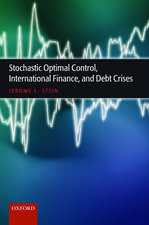Financial Intermediation in Europe
Autor Luke Drago Spajicen Limba Engleză Hardback – 31 oct 2002
| Toate formatele și edițiile | Preț | Express |
|---|---|---|
| Paperback (1) | 638.24 lei 43-57 zile | |
| Springer Us – 23 oct 2012 | 638.24 lei 43-57 zile | |
| Hardback (1) | 644.63 lei 43-57 zile | |
| Springer Us – 31 oct 2002 | 644.63 lei 43-57 zile |
Preț: 644.63 lei
Preț vechi: 758.38 lei
-15% Nou
Puncte Express: 967
Preț estimativ în valută:
123.37€ • 128.32$ • 101.85£
123.37€ • 128.32$ • 101.85£
Carte tipărită la comandă
Livrare economică 14-28 aprilie
Preluare comenzi: 021 569.72.76
Specificații
ISBN-13: 9781402070099
ISBN-10: 1402070098
Pagini: 252
Ilustrații: XVI, 230 p.
Dimensiuni: 155 x 235 x 19 mm
Greutate: 0.54 kg
Ediția:2002
Editura: Springer Us
Colecția Springer
Locul publicării:New York, NY, United States
ISBN-10: 1402070098
Pagini: 252
Ilustrații: XVI, 230 p.
Dimensiuni: 155 x 235 x 19 mm
Greutate: 0.54 kg
Ediția:2002
Editura: Springer Us
Colecția Springer
Locul publicării:New York, NY, United States
Public țintă
ResearchCuprins
1 Introduction.- 1.1 Financial and Monetary Integration in Europe.- 1.2 Synopsis.- 1.3 Collaborative Research.- 2 Banking under EU Integration.- 2.1 Introduction.- 2.2 The Single Market Programme and EU Banking.- 2.3 Assessing the Impact of Integration on EU Banking.- 2.4 Bank Pricing under Integration.- 2.5 Bank Strategies under Integration.- 2.6 Concluding Remarks.- 3 Theoretical Foundations of Financial Intermediation.- 3.1 The Nature of Financial Intermediation.- 3.2 Connecting the Financial System with the Economy.- 3.3 Modern Theory of Finance and the Problem of Banking.- 3.4 So What Do Banks Do?.- 3.5 Analysing the Bank Balance Sheet.- 3.6 Regulation in Banking.- 3.7 Concluding Remarks.- 4 The Analysis of Competition and Applications to Banking.- 4.1 Introduction.- 4.2 Competition Theory and Applications to Banking.- 4.3 Double Competition in Banking.- 4.4 Problems in the Analysis of Competition in Banking.- 4.5 Concluding Remarks.- 5 Contributions to the Theory of Banking Competition.- 5.1 Introduction.- 5.2 Balance Sheet Segmentation.- 5.3 Regulation of Bank Capital and Balance Sheets.- 5.4 Strategies in Banking Competition.- 5.5 Influences on Bank Pricing.- 5.6 Concluding Remarks.- 6 European Banking Responses to Yield Curve Impulses.- 6.1 Introduction.- 6.2 Connections Between Term Structure and Banking.- 6.3 Banking System Sensitivity to Monetary Policy.- 6.4 Empirical Evidence.- 6.5 Results: Tables and Simulations.- 6.6 Analysis of Results.- 6.7 Concluding Remarks.- 6.8 Appendix: Term Structure as Information About the Economy.- 7 Reflections.- 7.1 Contributors to Financial Economics.- 7.2 Monetary Integration: The View from Banking.- 8 Bibliography.















